One Day International (ODI) cricket has come a long way since it began in the early 70s to compensate for a rain-ravaged Ashes Test at the Melbourne Cricket Ground. From 60 overs to 50 overs, and from traditional white clothing to coloured clothing, ODI cricket has seen many alterations.
Arguably, most of the changes in the rules have been in favour of the batsmen, be it the 15-over field restrictions, the powerplays, or the free-hit as a penalty for bowling a no-ball. Not surprisingly, ODI cricket is sometimes referred to as a batsman’s game.
A score of 270 was considered match-winning in the 90s. 300 became the norm of sorts in the 2000s, and presently, even a 350-plus score is not considered safe. Over the years, ODI cricket has produced a number of batting superstars who have had fans swooning to their tunes.
In this article, we look at the top batsman of each decade since the advent of the one-day format.
#1 Sir Viv Richards (1970s)
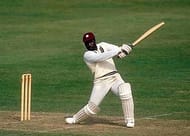
Although Greg Chappell scored the most runs in the 1970s, we go with Sir Viv Richards as the batsman of the decade. Richards had a better strike rate and average, and also scored more hundreds.
Chappell managed 919 runs in 22 matches at an average of 54.05, and a strike rate of 74.05 with one hundred. Richards, on the other hand, smashed 883 runs in 19 games at an average of 73.58 and a strike rate of 87.08, with three centuries to his name.
The most significant of the three tons came in the final of the 1979 World Cup at Lord’s against England. Richards blasted an unbeaten 138 from 157 balls with 11 fours and three sixes as West Indies rattled the hosts and lifted the trophy with a 92-run triumph.
The swashbuckling batsman’s first hundred of the decade also came against England at Scarborough in August 1976. Richards hit an unbeaten 119 from 133 balls, an innings featuring 20 fours and a six, as West Indies chased down 203 with ease. Another reason the game was special was because it marked the ODI debuts of future greats Graham Gooch, Ian Botham, Collis King and Michael Holding.
Australia too suffered at the hands of the big Viv as he bludgeoned an unbeaten 153 from 130 balls at Melbourne in December 1979, against an attack comprising of Dennis Lillee and Rodney Hogg. West Indies won by 80 runs as Richards’ brute force was very much on show.
Richards played a big role in increasing the popularity of ODI cricket just after its inception, and is hence considered the best batsman of the 1970s.
#2 Desmond Haynes (1980s)
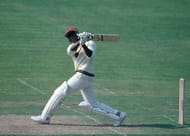
Richards dominated in this era as well, with 5,559 runs at a strike rate 91 over 156 matches. However, fellow West Indian Desmond Haynes pips him, only just, on consistency. The legendary Windies opener was the top run-scorer of the 80s, with 5,892 runs in 159 matches at an average of 43.32.
While his strike rate was much lower than Richards at 63.89, he made up for it with as many as 15 hundreds, which was quite a significant number for an opener, especially in the 80s.
Haynes’ best of 152 not out came off only 126 balls against India at Georgetown in March 1989. The innings, featuring 12 fours and 6 sixes, saw West Indies post an imposing 289 for 2 batting first. They went on to clinch the contest by an impressive margin of 101 runs.
Towards the end of the same year, in October, Haynes hit an unbeaten 138 from 164 balls against England at Gwalior as part of the Nehru Cup. He finished the decade with an undefeated 107 in the final against Pakistan. However, West Indies lost the final as Imran Khan came up with a stupendous all-round effort of 3 for 47 and 55 not out.
The most incredible aspect of Haynes’ hundred-hitting spree was that he hadn't scored a ton in the decade till January 1984, and yet finished the decade with 15.
En-route his impressive run, Haynes scored three hundreds in four matches against Australia (1984), and two in three games against New Zealand (1985). In the between the two tons against the Kiwis, Haynes hit an unbeaten 85. His amazing consistency during the course of the decade went a long way in making him a legend of the game.
#3 Sachin Tendulkar (1990s)
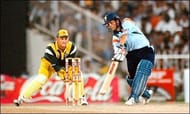
The era of the 90s was synonymous with the rise of Sachin Tendulkar. With 8,571 runs in 228 matches at an average of 43.07 and a strike rate of 86.81, scoring 24 hundreds, Tendulkar stood head and shoulders above the rest. His teammate and skipper Mohammad Azharuddin follows him on the list, with 6,858 runs in 225 matches at an average of a touch under 40.
Tendulkar’s numbers are phenomenal when we consider that the 90s saw some sensational talent making their mark in the format- names like Mark Waugh, Saeed Anwar, Aravinda de Silva, Brian Lara and Sanath Jayasuriya. While most of the above-mentioned names also dominated, Tendulkar’s hunger for runs stood out.
Much like Haynes, Tendulkar’s first hundred also came midway through the decade- 110 against Australia at Colombo in September 1994 as part of the Singer World Series. It was the beginning of many special knocks to follow against the Aussies. As many as 5 of his 24 hundreds in the 90s came against Australia.
1998 was a standout year for Tendulkar as he smashed as many as nine three-figure scores this year. Of course, the two most famous ones came at Sharjah in back-to-back games in April. His desert storm 143 took India to the final of the tri-series, in which the 'Master Blaster' smashed an unforgettable 134 on his 25th birthday, as India lifted the title.
At the start of the month, he had also thrashed the Aussies en-route to an 89-ball hundred at Kanpur, a knock featuring seven sixes. In October of the same year, Tendulkar’s 141 from 128 knocked Australia out of the Champions Trophy at Dhaka.
Another of his most brutal knocks came against New Zealand at Hyderabad in November 1999, when he spanked the hapless Kiwis on his way to register an unbeaten 186 from 150 balls.
It wouldn’t be wrong to say that the Mumbai maestro was next to impossible to stop in the 90s.
#4 Ricky Ponting (2000s)
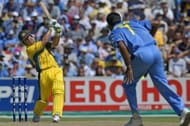
If Tendulkar was Mr. Dominant of the 90s, Aussie great Ricky Ponting took over the mantle in the next decade. In 239 matches, Punter amassed 9,103 runs at an average of 44.18 and a strike rate of 84.44, with 23 hundreds. Tendulkar was close as well, with 8,823 runs in 211 games at an average of 46.68, with 21 hundreds.
While there is not much to choose from between Ponting and Tendulkar in this decade, the former gets the nod as he starred in two World Cup wins, as Australia remained undefeated in both the editions of the game’s premier tournament.
His standout knock was an astonishing 140 not out from 121 balls at Johannesburg in the 2003 World Cup final against India. Sourav Ganguly’s men could not recover from the brutal onslaught and succumbed to defeat by 125 runs. Ponting further gathered one hundred and four fifties in the 2007 World Cup edition that followed in the Caribbean.
Ponting’s blazing 164 from 105 balls at Johannesburg in March 2006, featuring 13 fours and nine sixes, has unfortunately become a side note in South Africa’s world record chase. The aggressive Aussie hit back-to-back tons against rivals New Zealand at the start of 2007, and followed it up with two more at the end of the year against the same opponents.
Ponting’s aggression and run-scoring ability made life miserable for the best of bowlers across the globe, and he was truly a trailblazer in this decade.
#5 Virat Kohli (2010s)
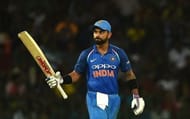
This was the easiest pick of the lot. Current Indian skipper Virat Kohli has lorded over the rest in the decade that just ended.
In 227 matches, Kohli amassed an unbelievable 11,125 runs at an average of 60.79 and a strike rate of 94.11, with a staggering 42 tons. Kohli’s deputy Rohit Sharma is next on the list with 8,249 runs in 180 games at an average of 53.56 and a strike rate of 90.63, with 28 hundreds.
While Kohli is adept at setting totals, what sets him apart from most other batsmen is that he has proved to be the master of the run chase.
His career-best till date of 183 came in the high-scoring Asia Cup clash against Pakistan at Dhaka in March 2012. India were set to chase a massive 330 to win after hundreds from Mohammad Hafeez and Nasir Jamshed. However, Kohli made a mockery of the target with his blazing knock, featuring 22 fours and a six.
Kohli’s knock was part of a run in which he scored four hundreds and a fifty in five games. This phase included the 133 not out from 86 balls against Sri Lanka at Hobart, a match in which he famously tore apart Lasith Malinga (1/96 in 7.4 overs). His other two hundreds also came against the same opponents, at Dhaka and Hambantota respectively.
His twin hundreds in the high-scoring 2013 home series against Australia- 100 not out from 52 at Jaipur, and 115 not out from 66 at Nagpur- also played their part in India’s famous series win. Kohli has scored consecutive hundreds on multiple occasions, and his ability to convert starts into centuries is unparalleled.
It is not without cause that Kohli is perceived to be the successor to Tendulkar’s throne in the world’s best batsman conversation.
Brand-new app in a brand-new avatar! Download CricRocket for fast cricket scores, rocket flicks, super notifications and much more! 🚀☄️
